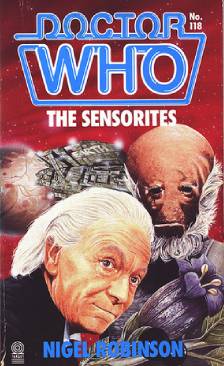
Synopsis: The TARDIS lands on a spaceship orbiting an alien world. The crew of the ship appear to be frozen but suddenly they wake up, dazed and confused. Two visitors from the planet arrive and insist the travellers join them on their world. Leaving Barbara behind on the ship, the Doctor, Susan and Ian meet the Sensorites, a race of beings with telepathic abilities and a sensitivity to bright light. But there is revolution from within as a small faction of Sensorites plot to take control. Meanwhile, Ian falls victim to a mysterious illness…
Chapter Titles
- Prologue
- 1. Strangers in Space
- 2. War of Nerves
- 3. The Dreams of Avarice
- 4. The Unwilling Warriors
- 5. The Quest for Freedom
- 6. Hidden Danger
- 7. A Race Against Death
- 8. Into the Darkness
- 9. Surrounded by Enemies
- 10. A Conspiracy of Lies
- 11. The Secret or the Caves
- 12. A Desperate Venture
- Epilogue
Background: Nigel Robinson adapts scripts by Peter R. Newman for a 1964 story, breaking the record for biggest gap between broadcast and novelisation (22 years, six months, three weeks).
Notes: A moody prologue establishes the survey ship above the atmosphere of the Sense Sphere. The ship is nearly a fifth of a mile long and was nearly at the end of its four-year mission when it became caught in that region of space. There’s an elegiac introduction for Susan:
No longer a girl, and not yet quite a woman, her closely cropped hair framed a face of almost Asiatic prettiness, and her dark almond eyes belied an intelligence far beyond her tender years.
Barbara is tall and tidy, in her late-twenties and with a ‘stern purposeful face’ that possesses ‘a melancholy beauty’. She’s also dressed in clothes appropriate to the 1960s, though hers are more conservative than Susan’s, reflecting ‘her maturer years’. Ian is said to be a ‘stocky well-built young man, while the Doctor is ‘an intellectual giant’ and ‘an alien cut off from his home planet by a million light years in space and thousands of years in time’ (finally – someone knows that light years are a unit of distance!). We’re reminded of the travellers’ recent moral dilemma over the culture of the Aztecs as well as their first meeting in the junkyard.
Maitland is provided with an efficient reason for accepting the travellers’ lack of 28th-century knowledge, assuming they’re from an earlier time, pre-hyperspace-travel, when cryogenics were commonplace; it’s apparently a frequent experience for modern travellers to overtake those from previous generations. Ian and Barbara’s rather slow onscreen journey through the corridors of the ship is transcribed as a hideous ordeal where they’re surrounded by evil spirits and bogey-men. The Sensorites are described as possessing an ‘almost Oriental inscrutability’ (a phrase that may trigger some modern readers who may view it as representing outdated imperialism, but is less distressing in the UK where many Chinese-themed takeaways and restaurants still use the word in their name).
The Doctor identifies the humans as being members of a lost Interstellar Navigation, Exploration and Research party (‘INNER’, correcting a contradiction on-screen between what Hartnell says ‘I-N-N-E-R’ – and what the badge reads – ‘INEER’). The Sensorites provide Susan and Barbara with a 3D holographic map of the city and the caves. The final argument between the Doctor and Ian is omitted (even though the very next novel to be released follows on directly from this). Instead, Barbara fears for the future of the Sensorites now that first contact with humans has been made:
Maitland, Carol and John were good people and would guard the Sensorites’ secret well. But she remembered other instances in Earth’s history when promises had been made and then broken; when secrets had been kept and later betrayed. She remembered the dreadful consequences of such actions: the callous exploitation of the Indians of North America, the Aborigines of Australia. In their own naive way the Sensorites were just as helpless as them.
Cover: Nick Spender’s cover shows the Doctor, a Sensorite and a bloom of deadly nightshade. Spoilers, Nick!
Final Analysis: As with The Space Museum, The Sensories is unlikely to be a favourite for many – as pointed out by Tim Worthington ; even if you’re a fan of the first Doctor, it’s slow, small-scale stuff that feels rather dated now. As his time as editor was coming to an end, Nigel Robinson was cautious about commissioning himself to write a novel, so taking on this unloved adventure was a canny idea. And it’s a surprising success. Firstly, Robinson captures the regular characters beautifully. Secondly, he effectively increases the menace without rewriting what is seen onscreen; instead, he provides insight to the mental terror experienced by Ian and Barbara, as well as the attacking beast in the caves, which on TV is obviously just a dishevelled man. He brings a much greater depth to the rather generic and unintentionally comical Sensorites, imbuing them with a sense of culture that helps to explain away some of the more patently ludicrous plot holes; and there’s even compassion for the human survivors of the crashed rocketship:
They weren’t evil – like all men at war they believed totally in the rightness of their mission – but they were mad, and what they were playing at was no more than an elaborate and very deadly game of soldiers.
This is all the most surprising when we remember that though Robinson has edited many works by other authors by this time he left WH Allen, this is his very first self-penned novel. It has all the efficiency of a Terrance Dicks, the empathy of Malcolm Hulke and Ian Marter’s ability to heighten the sense of menace. I’m looking forward to seeing what he can do with a more worthy story.

Occidental College is “The Liberal Arts College in Los Angeles” so I can’t see why someone would complain about the use of the word Oriental, they simply mean Eastern and Western. Though Susan doesn’t really look very eastern, but Waris Hussein himself felt she had an exotic quality to her looks.
LikeLike
It’s because it positions China solely in relation to the British Imperial map.
LikeLiked by 2 people
Yes, I suppose so. The inscrutability cliche is also one that always puzzles me. I do wonder if conjurors made it up.
LikeLiked by 1 person
The “INNER” thing seems to be a misunderstanding by Robinson of Hartnell’s fluff, it’s half of the torn-off rank badge of an “ENGINEER”. from the Earth expedition.
LikeLiked by 2 people
“It has all the efficiency of a Terrance Dicks, the empathy of Malcolm Hulke and Ian Marter’s ability to heighten the sense of menace. I’m looking forward to seeing what he can do with a more worthy story.” I am, too. On my most recent read-through, I remember that I couldn’t think of a more appropriate writer to complete work on Ian Marter’s last, posthumously published book.
LikeLiked by 1 person
Odd that Michael Eavis earned some pocket money by posing for that cover. Still, Bill Hartnell looks amused.
LikeLiked by 1 person